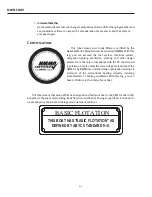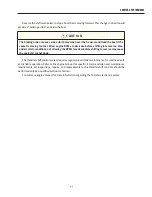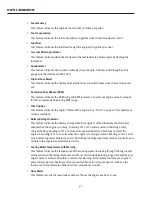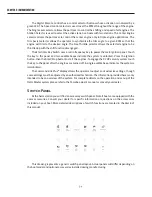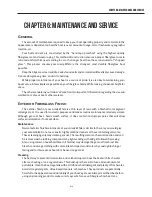
3-5
Chapter 3: General Information
Towing
In the event of a mishap or power loss you may need to tow a boat or be towed. You should not
tow a boat larger than your own. Always use safety and good judgment when towing. Never tow a
boat if you are not equipped with the proper lines. Passengers should never grasp a towline. It
should be secured to the boat. See page 39 in Sportfish, Cruisers, Yachts Owner’s Manual.
Before towing a boat, make a bridle and tie it securely to the pad eyes on the transom with
enough slack to clear the engines. Pad the line wherever it comes into contact with the boat to
prevent chafing. Attach a tow line to the bridle so that it can slide from side to side to prevent too
much pressure on a single pad eye. The tow line should then be attached to the bow eye or to a
bridle on the towed boat. The tow line should be a minimum of twice the length of the towing boat,
the longer the better. Do not try to run in too close when passing the towline to the other boat. Send
either a light line or attach the towline to a life preserver to be pulled in. Be aware of the other boat’s
propeller.
The towed boat should always have someone at the wheel since the boat may swing off course.
Start the tow off slowly; a steady pull at a moderate speed should be used. It is important to keep
the slack out of the propeller area. Watch the action of the towing boat. If excessive slack develops
in the towline and contact is obvious, turn in either direction to avoid hitting the stern.
WARNING
As a precaution, passengers on both boats should stay clear of the towline; lines under stress
could snap and fly in either direction causing injury.
Shallow Water
Most boats that become grounded can be floated off with engine(s) tilted to reduce the draft at
the transom. With motors tilted, try rocking the boat from side to side to break the suction of mud
from the keel. Move passengers or heavy objects from the point where the boat is grounded. Do not
lower or start the engine(s) until the boat is clear of the ground. Refer to page 63 in Sportfish,
Cruisers, and Yachts Owner’s Manual
.
CAUTION
Do not lower or start engines if the propeller is in mud or sand. Wait until the boat is refloated
to avoid damage to the cooling system of your engine.
Be mindful of water level fluctuations when boating in water with tidal changes. If you are
grounded on an incoming tide, you can wait until the tide is high enough to refloat your boat.
However, on an outgoing tide, quick action should be taken to refloat your boat. If this is not
possible, set an anchor to keep the boat from becoming driven further aground. Set the anchor to
counter the action of the wind or current. The anchor, in some cases, can also be used to pull the
boat free.
Summary of Contents for Canyon 306
Page 2: ......
Page 10: ...1 4 Chapter 1 Consumer Information ...
Page 26: ...3 8 Chapter 3 General Information ...
Page 32: ...4 6 Chapter 4 Performance ...
Page 43: ...6 7 Chapter 6 Maintenance and Service ...
Page 44: ...6 8 Chapter 6 Maintenance and Service ...
Page 72: ...9 4 Chapter 9 Warranty ...






